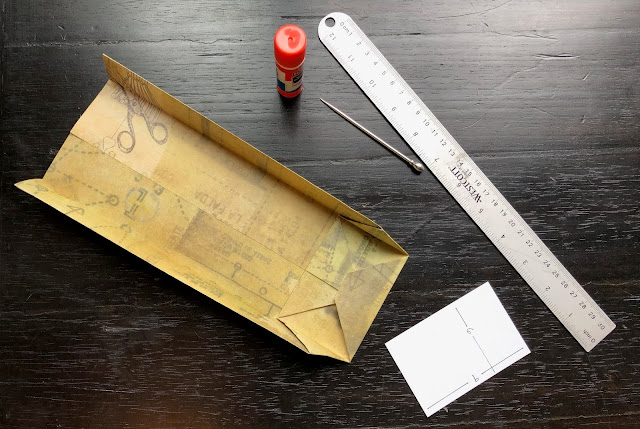The bag of your dreams has three dimensions.
Let's call the height H. There are two dimensions forming the rectangle at the bottom of the bag, so let's make one longer than the other by at least 1 centimeter, and call the longer of the two L. The shorter one will be W.
Assuming we would like an overlap of 1 centimeter for seams*, you will need:
1. A piece of paper of dimensions (2L+2W+1) by (H+W/2+3/2)
2. A ruler
3. A pencil for lightly marking measurements
4. A blunt pointy object for tracing creases (olive skewer, pen that doesn't work, etc.)
5. Some form of adhesive (glue stick, double sided tape, etc.)
Optional materials include:
1. A thin cardboard or paper insert of dimensions L by W
2. Handles (paper, twine, ribbon, etc.)
3. Adhesive for handles (glue and strips of paper, tape, hole punch, etc.)
4. Decorations (stickers, stamps, paper cutouts, etc.)
Step 1:
Place your rectangle in front of you so that (2L+2W+1) is going left to right, (H+W/2+3/2) is going up and down, and the prettiest side of the paper is facing down. The edge furthest away from you is the top of the bag, and we're going start by folding a stabilizing border. Using your blunt object, trace your ruler and lightly press a horizontal line into the paper 1 centimeter down from the top edge. Fold down towards you along this indentation.
Step 2:
Using two points of measurement to ensure accuracy, measure [(L+W)/2+1/2] from the left side of the rectangle, make an indentation along this vertical line, and fold towards the center. Do the same on the right side. The pretty side of the paper is now the outside of the bag, and there should be an overlapping seam in the middle. Seal it.
Step 3:
Using two points of measurement to ensure accuracy, measure (W/2) from the left, make a vertical indentation, and fold towards the center. Do the same on the right side. Open these folds and invert the step 2 folds so they are inside the bag and flatten. Open these folds again.
Step 4:
Using two points of measurement to ensure accuracy, measure (W+1/2) up from the bottom of the rectangle, make a horizontal indentation, and fold upwards. Unfold. Fold the bottom left corner up so that it meets this crease and forms an isosceles right triangle. Do this with the right corner. Unfold both triangles.
Step 5:
Using the horizontal crease and both triangles, open the top layer and flatten upwards. This is called a squash fold.
Step 6:
Using the folds you made in step 3 as a guideline, measure (W/2+1/2) up from the bottom of the squash fold, make a horizontal indentation, and fold upwards. Fold the top flap of the squash fold downwards by the same dimensions. You should have a 1 centimeter overlapping seam in the middle of the bottom of your bag of length (L-W). Seal it, along with the four overlapping triangles on the bottom of the bag. In fact, if you would like to insert the bottom cardboard under these flaps before sealing, you could glue both flaps down in their entirety.*
Step 7:
Refold the step 3 folds towards the center of the bag. Open the bag and invert the sides from step 2 once again, taking care to maintain crisp, neat edges towards the bottom of the bag and also along the top border.
Step 8:
If desired, decorate, line the bottom with a cardboard insert, and attach handles. Maybe make a bunch for some people attending bridal parties; I don't know. I'm not good at that part.
* If you don't like the gap left by the squash fold, you could to widen your overlapping seam from 1 to (L-W). This means your new equations would be transformed as follows:
2L+2W+1
|
becomes
|
3L+W,
|
H+W/2+3/2
|
becomes
|
H-W+3L/2,
|
(L+W)/2+1/2
|
becomes
|
L,
|
W/2
|
stays
| W/2, |
W+1/2
|
becomes
|
W/2+L/2, and
|
W/2+1/2
|
becomes
|
L/2.
|
PS. A limiting factor for making your own paper bags is that (2L+2W+1) is rather large. However, there is no need to give up! Using a thicker selection of wrapping paper, a few layers of newspaper, or even gluing several pieces of paper together to extend the width of your rectangle can solve this problem. Good luck!


















Looks very nice, hon.
ReplyDelete